Hi, the previous Sunday I got the regular gaming group together to playtest my project that I've been working on for nearly a year. It is skirmish games between native American tribes set in the 17th-18th century. Since we use the "Song of Blades and Heroes" series of rules from Ganesha Games (
http://www.ganeshagames.net/) for other periods, my first choice was to try it out with these rules. I made a few modifications, chiefly involving in "porting in" concepts from other rules sets in Ganesha's series (which all use the same engine, so to speak).
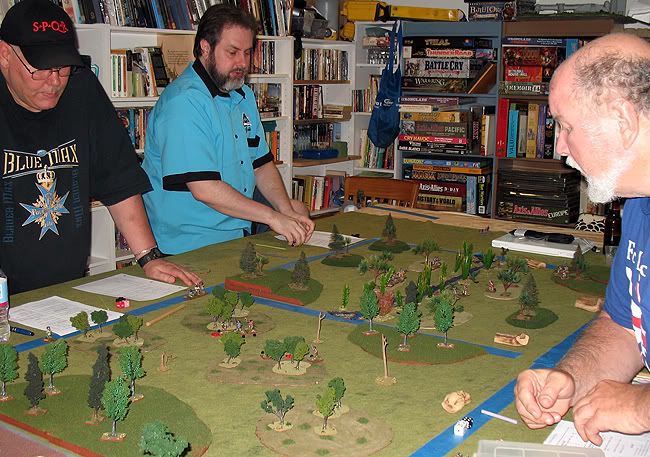 I set up 3 one-on-one battles next to each other to playtest the rules
I set up 3 one-on-one battles next to each other to playtest the rulesI had six players so I decided to set up three separate one-on-one battles rather than one big, multiplayer scenario. I figured I'd get more variety and viewpoints for feedback. The forces are a wee bit undersized -- the rules recommend 400 point forces, while mine totaled out in the 315-320 range. That translated to each player commanding 7 miniatures (which used all 42 of my miniatures I'd painted up!). This meant the games lasted from one hour to an hour and a half for the longest. I am fairly satisfied with that length because I know multiplayer games will take longer, padding it out to a nice convention length. It also means if (when?) I decide to run a campaign I can get in a couple of battles per player in an evening. We did that with another campaign a friend of mine ran (using their post-Apocalyptic set, Song of Mutants & Death Ray Guns), and it worked out really well, I thought. So, I'd like to leave that possibility open.
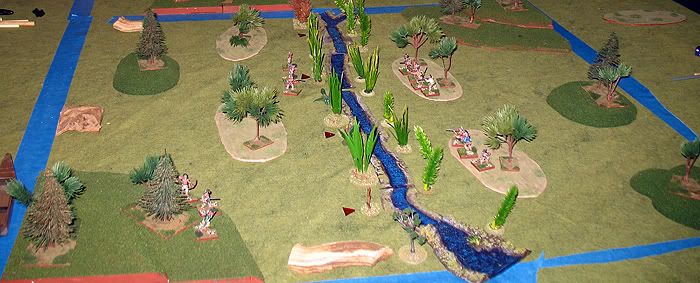 In this battle, Erie Indians were hunting down the canoe that had brought a Fox warparty into their territory, while the Fox tried to make it there first
In this battle, Erie Indians were hunting down the canoe that had brought a Fox warparty into their territory, while the Fox tried to make it there first Anyway, the players were all very happy with how the rules worked. I'd pointed out the aspects of the rules beforehand that might seem knobbly to them, but none of them objected to how they played out. They thought the format of the rules worked well with the period and scale. With Ganesha Games rules, each model has two basic stats: Quality and Combat. Combat is simple -- you add your roll of a d6 to it (plus any weapons or tactical modifiers) and compare it to the enemy's score. Quality is the figure's motivation and morale. When activating that figure, a player may choose to try for 1, 2 or 3 actions. They must roll equal to or higher than their Quality score to be successful. So, a figure with a Quality of 4 that chooses three activations and rolls a 2, 4 and 6 would get two actions. There is a +1 bonus if they are close enough to their leader.
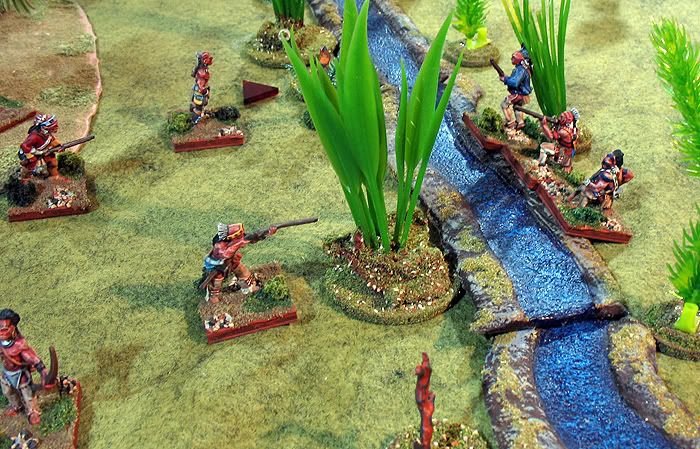 The Fox and Erie exchange musketry through the thick vegetation growing along the banks of the river
The Fox and Erie exchange musketry through the thick vegetation growing along the banks of the riverThe interesting thing about this activation system is that if you roll two failures on any attempt to activate a figure your turn is over. So, you can be conservative and try just one activation for all your figures and ensure all get a chance to activate. Or you can go for broke and try for three, increasing your chances of a "turnover." It's a nice aspect of the system that makes players' decisions important. Too many games out there leave little choices for the player to make. I find that is one of my defining factors on what makes a good game or not. If all the players can do is march forward and roll dice I don't think it's much of a game.
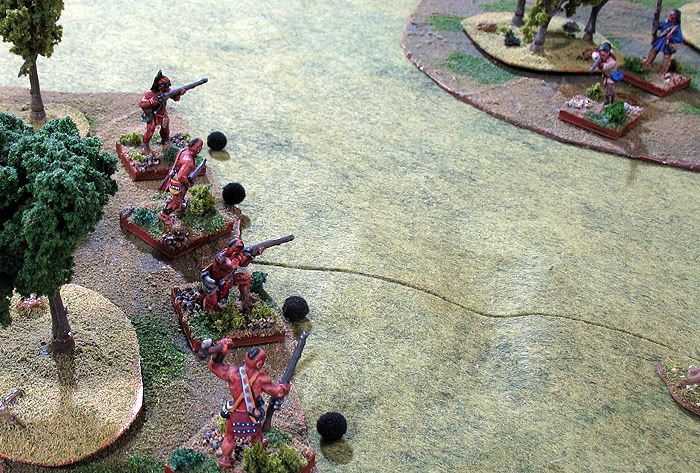 In general, I'm not a fan of markers on the miniatures table -- but these little black puffballs to denote muskets that have been fired and not reloaded aren't too obtrusive
In general, I'm not a fan of markers on the miniatures table -- but these little black puffballs to denote muskets that have been fired and not reloaded aren't too obtrusiveSpeaking of decisions, I think one reason why this rules set works for me in this period is that players must decide when to not reload their musket and instead charge in with tomahawk or warclub. It forces the players to weigh their advantages and constantly size up the situation. If your braves have a chance of charging in and catching the enemy outnumbered or at a disadvantage, do you go for it? Or do you hunker down in cover and snipe away?
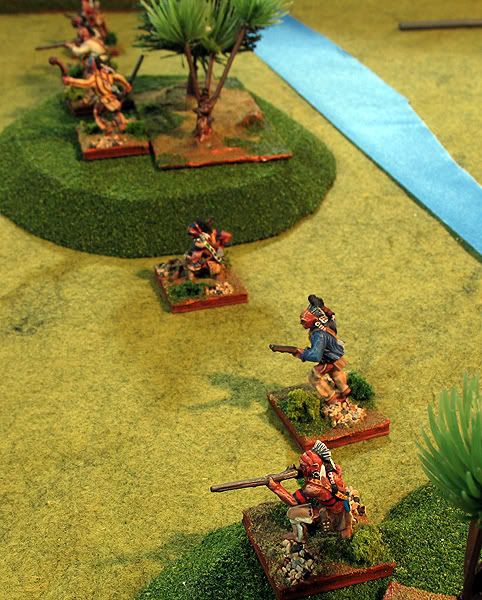 On the hunt for enemy scalps!
On the hunt for enemy scalps! Anyway, I'll post more about the project as we play more. I'm in the process of building terrain for it, now. Look for pics of that, too!
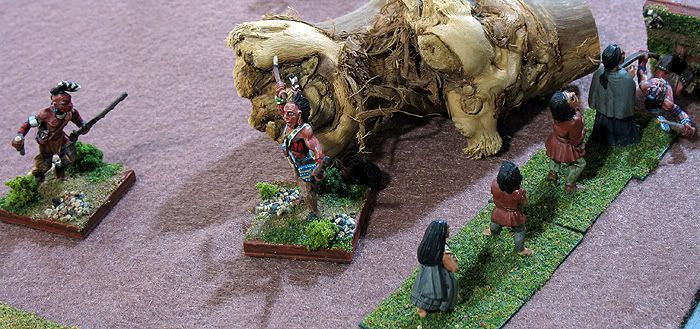 The bitter end of a Seneca raiding party as Hurons close in and prepare to free the captives
The bitter end of a Seneca raiding party as Hurons close in and prepare to free the captives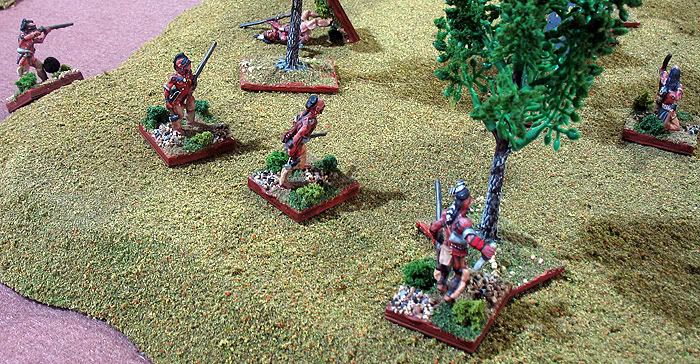 As historically, fighting is done at short ranges in the Eastern Woodlands of North America
As historically, fighting is done at short ranges in the Eastern Woodlands of North America